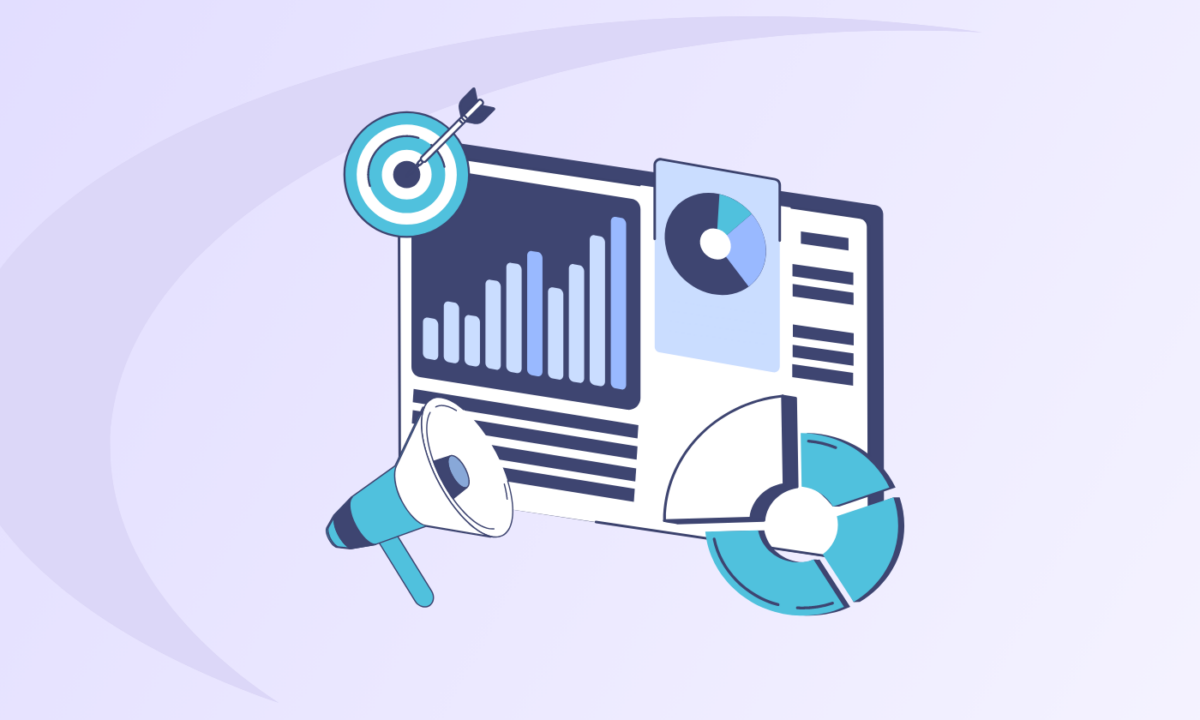How Does Bounce Rate Affect SEO and How Can You Fix It?
As a business website, ensuring that your SEO performance is at par with the other major competitors in your industry might very well be one of your top priorities.
You could have a lot of high-quality content, a completely functional website, rank high on the SERPs, and still have website visitors who land on your website only to click away from it immediately. While this can be demotivating, it helps to understand why this might be happening and the ramifications of too many visitors bouncing away from your website.
Let us dig deeper into this, and understand all about bounce rates, and their impact on your SEO strategy and performance, along with what you can do to fix it.
Understanding Bounce Rate
Google is the most popular search engine for a good reason. Its success can be attributed to its ability to “understand” what users are looking for, even if they do not make their search query, very detailed.
When a user clicks on a search result on the SERP, Google pays attention to how long they stay on the page. If the user lands on that page and immediately abandons it, Google takes it as a signal that the user did not find it useful. This action of a user visiting a website and then jumping off it is referred to as bouncing.
Bounce rate is defined as the number of website visitors who navigate off the website after viewing only one page – generally represented in the form of a percentage.
For instance, say you have an HVAC business based in Adelaide. You have a Wix website that you use to showcase your services and book enquiries. If the bounce rate on your website is 75%, it means that 75 out of 100 people who visited your website left the page they were looking at, without engaging with it.
Bounce rates can be especially daunting for eCommerce websites that depend on users spending time on product pages that can then convert them into paying customers. Bounce rate and exit rate in SEO are often talked about together but you should not confuse the two metrics. While they are very similar, exit rate is used to refer to those visitors that have browsed your websites and left from a specific page. On the other hand, bounce rate is for users who abandon the first page that they click on to get to your website.
Does Bounce Rate Affect SEO Performance?
At this point, we have talked enough about bounce rate for you to know that it is something worth tracking for your website performance. However, it is important to know exactly how does bounce rate affect SEO, to fully understand why it is important to keep it on the lower side.
Before we get into the merits and demerits that your bounce rate may have on your SEO performance, let us get an important question out of the way. Is bounce rate a ranking factor? The short answer is no.
Even then, let us now talk about the relationship between your SEO performance and bounce rate. You may already know that Google is quite secretive about its algorithms, and you only get a better understanding of them with the help of industry experts and observers.
While several major experts speculated in the past that bounce rate seems to be a Google ranking factor. While your bounce rate can influence the way your website may perform and rank on the SERPs, no Google official has ever confirmed this speculation. There is, however, enough proof that Google does use a similar metric as an important factor while ranking websites.
In “How Search Works”, Google describes “aggregated and anonymous interaction data” as the basis for deciding whether a specific webpage is relevant to users’ search queries. It seems like Google is referring to a metric similar to bounce rate in this part.
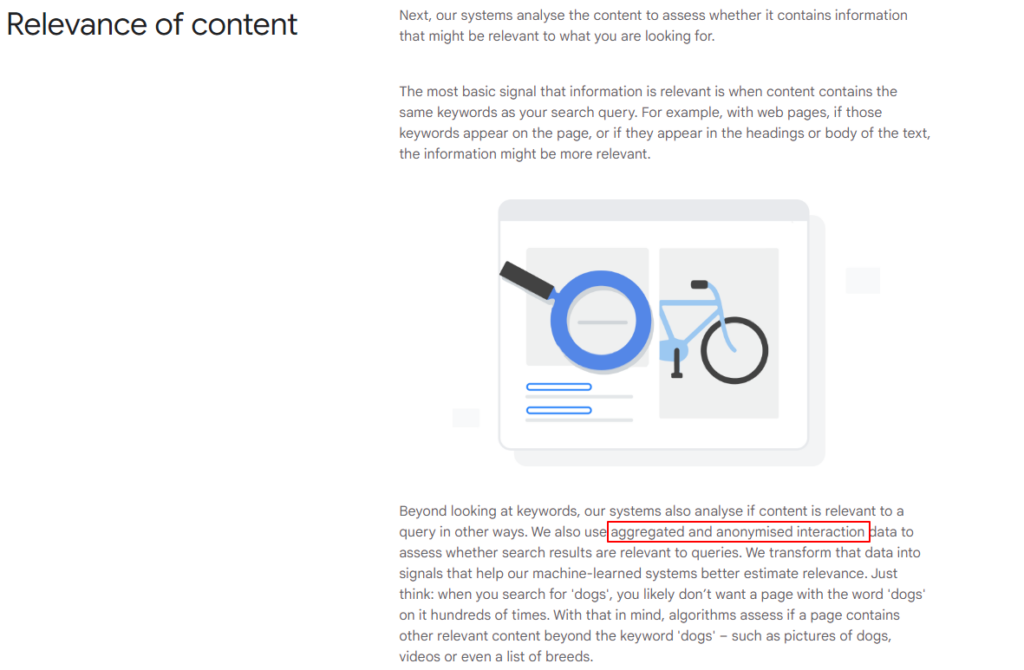
This means that a higher bounce rate may not influence your search engine rankings directly, but will impact the way search engines perceive the usefulness and relevance of your website while ranking it.
Not just this, higher bounce rates also pinpoint potential weaknesses in your website such as —
- Low-quality website design
- Poor mobile optimisation
- Slow loading speed
- Lack of alignment between keywords and content
This is important to understand at this point because if you want to reduce your bounce rate, you will probably need to work on one or more of these things. Improving any of these areas of your website will ensure that you see a visible improvement in your current SEO performance.
At this point, it is also necessary for you to know why Google does not consider bounce rate a ranking factor, even though Google Analytics measures bounce rate. The primary reason is that your bounce rate is not an indicator of the quality of your website. Another reason is also that not all websites use Google Analytics, and even if they do the data can be easily manipulated.
5 Factors That Can Influence Your Bounce Rate
Now that you know how bounce rate affects SEO and overall performance of your website, it is time to focus on the actionable part. Before we go any further and talk about calculating and fixing your bounce rate, let us understand the factors that contribute to higher bounce rates.
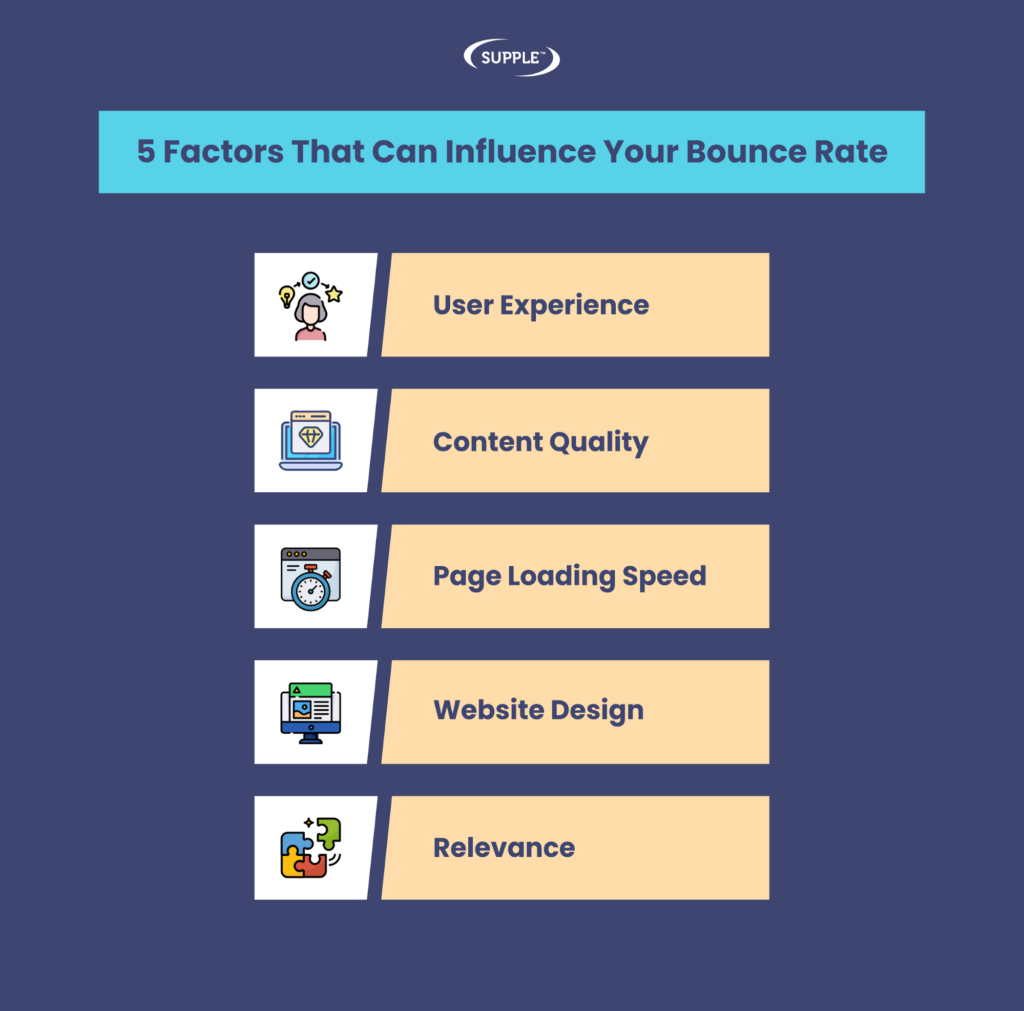
- User Experience
The user experience you deliver to your website visitors can affect your bounce rates. If your website has confusing navigation, slower load times, intrusive pop-ups or unresponsive design, your users will not like being on your website for long. Such aspects can frustrate your visitors quite easily and lead them to motivate them to leave your website.
- Content Quality
Regardless of the reason that led to a user landing on your website, your content will make your users want to stay on your website or leave it. After all, your website content is crucial when it comes to engaging your visitors. Content that is of low quality such as poorly written articles, outdated material and irrelevant data and information. Such content usually fails to capture the attention of your users, which can make them leave your website.
- Page Loading Speed
Users today have limited attention spans and patience, especially when they are browsing online. They want websites to load quickly, and to receive necessary information as soon as possible. If your web pages are loading too slowly, it can easily frustrate your visitors and make them want to abandon your website. Your page load speed can be optimised by compressing images on your website, browser caching, and minimising server response time.
- Website Design
Your website design can help you retain and attract visitors. Several aspects of your website such as outdated aesthetics, cluttered layout, and excessive use of advertisements can derail your overall website design. However, such factors can easily demotivate your users from staying too long on your website, and increase your bounce rates.
- Relevance
When a user lands on your website, they are looking for content that matches their needs and interests. Such content can engage them, and ensuring that your content is relevant, aligned with user expectations, and targeted can help you reduce bounce rates. On the other hand, irrelevant content or misleading content can lead to a lot of dissatisfaction and prompt users to leave your website.
How to Calculate Your Bounce Rate
Now that you know the primary factors that influence your website’s bounce rate, let us move on to calculating the bounce rate of your website. Simply put, your bounce rate can be calculated by dividing your single-page sessions divided by the total number of sessions.
Say, the Shopify website for your accounting services business in Perth gets 1000 website visitors (total sessions) every month. Out of these visitors, 620 website visitors abandon the page that they land on immediately without visiting any other webpage on your website i.e. single-page sessions. This means that the bounce rate of your business website is 62%.
8 Effective Ways to Fix Your Bounce Rate
Before you go ahead and start calculating or tracking the bounce rates on your website, you should put a fair amount of effort into reducing your bounce rate. So before you go ahead, ask yourself how can you reduce bounce rate in your SEO performance and find ways to do it effectively.
- Implement a Proper Internal Linking Structure
You have probably heard a lot about the importance of internal linking structure for your SEO performance. When a user lands on a specific page on your website, your internal links are how they discover the other pages.
When you are working on reducing your bounce rate, having an internal linking strategy is a good starting point. By discovering relevant links on the webpage that they land on, your website users are more likely to spend more time on it. This will also help them navigate your website and find specific sections easily, contributing to an enjoyable user experience.
You can increase the time spent by users on your website, by adding internal links to other posts in your blogs so that users can have a cohesive and useful reading experience. However, like all things healthy, internal links should be inserted in moderation, as too many can ruin your SEO performance and even increase your bounce rate.
- Optimise Your Content for Better Performance
Your content is the king that rules over all your digital marketing channels. Optimising your content will make sure the users who land on your website stay for the content. If your content is hard to read, you can be sure that your users will not read it.
Instead, try to do different things while creating content to optimise its performance and role in your SEO strategy. One of the basic things you can do is add more white space so your content gets more room to breathe. Break down your longer paragraphs into easily skimmable content that users can quickly navigate. Even something as basic as using fonts of appropriate size can make all the difference.
Another important factor you should consider is utilising different kinds of content so that you can engage your audience more effectively. Content formats such as images and videos can especially help you improve your user experience.
- Rework Your Product Pages
Regardless of what industry you operate in, your service pages and product pages occupy the most precious real estate on your website — and rightly so. Ensure that you highlight the most useful information about your product, its pros and cons, as well as any other crucial product-related information that might help customers make a purchase decision.
You should also have high-quality images that are optimised and represent your product well. While it is true that a visitor bouncing off your product page might simply be because the product didn’t fit their requirements or aversion to the price point, there may be other reasons. You can eliminate these other reasons by including key details and answering potential questions about your product, thus helping customers make purchase decisions quicker.
- Implement an Efficient Navigational Structure on Your Website
How often have you found yourself lost in a sea of web pages while browsing your website? This scenario is especially very frustrating when you think you have landed on the right website for your requirements. It might even make you change your mind, and go right back to the SERPs and look for another solution.
Your website visitors will feel the same if you do not have a logical and structured navigation for your website.
The navigational structure of your website might seem like a trivial thing at the outset but is valuable to visitors who are looking to find solutions quickly. Find the ideal structure for your website based on your target audience and offerings, and design it accordingly to reduce bounce rates.
- Optimise for Mobile-Friendliness
Mobile users dominate the web traffic by making up more than half of the user base. This should tell you that if your website is not mobile-friendly, you need to work to remedy this immediately. No user would like to navigate a desktop website squished into a mobile screen and would immediately abandon it.
Remember, it is not only enough to offer a mobile-ready website experience to users, but to also make it engaging for your users. Your mobile-friendly website needs to offer a stellar and preferably interactive user experience. You should consider using different types of content to ensure the mobile-friendliness of your website.
We recommend Google’s Mobile-Friendly Test tool to test the mobile-friendliness of your website, and to get the reassurance that your website is ready for mobile-first indexing.
- Minimise Sidebar Widgets and Advertisements
On any webpage, minimising distractions is a great way to keep your users engaged and make them stay longer. Having popups, widgets and advertisements may seem like good opportunities for getting more eyeballs for your brand, but it can be counterproductive if there are too many of them.
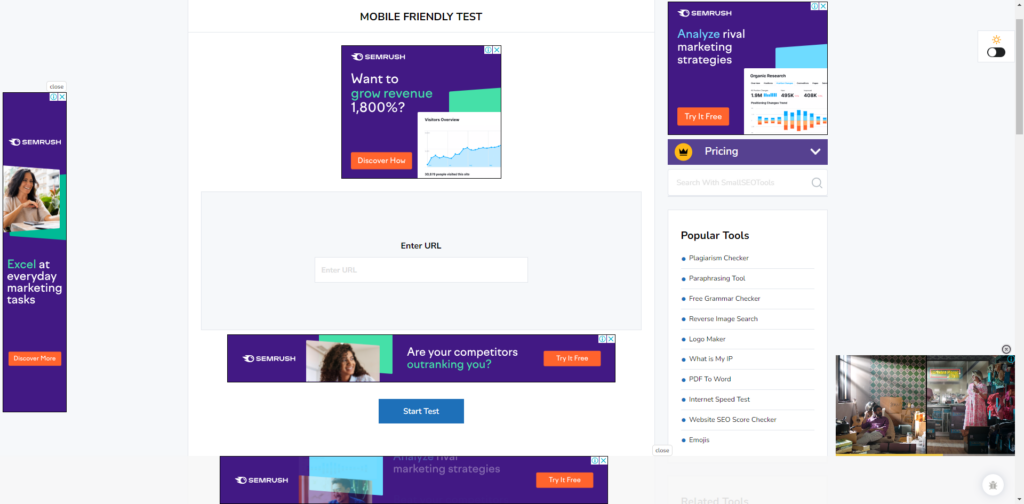
For instance, take a look at this website. It is hard to even see the main part of this page — the tool, because of all the advertisements and popups that fill the screen as soon as you land on the website.
Minimise these distractions on your conversion-oriented landing page as much as possible, and instead go with having a highly effective and well-positioned CTA. Along with this, if you also have impactful copy complete with useful information, you can be more assured that your users will engage with your website, and may even convert into paying customers.
- Work on Your Page Loading Speed
Site speed is an important metric that contributes to your overall SEO performance. More importantly, one of the easiest ways to fix your bounce rate is to improve your website speed and page loading speed.
Most users do not have much time at hand when they are browsing the internet and through a website. You only have a few seconds to convince a user to stay on your website, so the speed at which your website loads can make or break your first impression.
You should optimise your images and content, utilise a Content Delivery Network (CDN), implement a strong caching mechanism, and use other similar activities to improve your website speed significantly.
You can use SEO tools like Pingdom and Google PageSpeed Insights to check your page loading speed and identify if any improvements are required.
- Ensure Alignment Between Your Keywords and Content
Imagine landing on a website because it seemed to have content that matched the intent of your search query, only to find that the actual content does not match at all. You will waste no time in clicking the back button and exiting the website, right?
You want to deploy the same line of thinking when you are planning keywords and content for your website visitors. Keyword mapping is a process that you should ignore while creating or optimising your website content.
Take time to understand the search intent behind a specific keyword while conducting your keyword research and ensure that you optimise content to address the intent perfectly. This will help you ensure that your customers find relevant content when they land on your website, and prevent them from bouncing away.
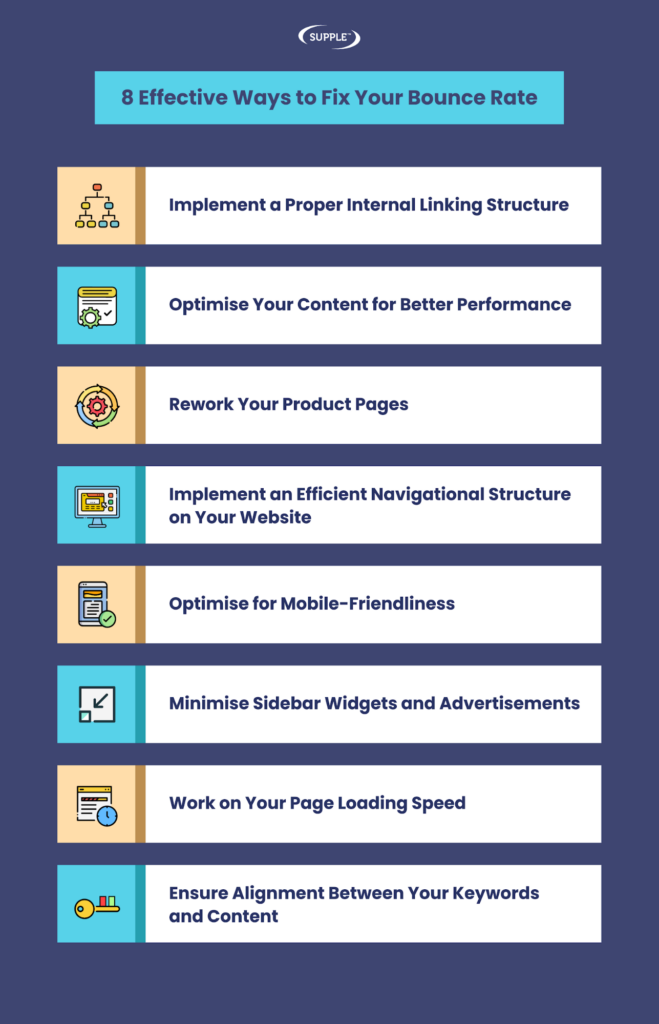
Prevent Bounce Rates from Derailing Your Website Performance
As you now know, bounce rates if left unaddressed, can ruin your SEO performance and your overall website experience. It is important to have a strong measuring mechanism in place to ensure that your bounce rates are in control and do not hamper the sales you generate or the user experience you deliver. Leverage some of the strategies mentioned above to ensure that your bounce rates are always optimised. Get in touch with us so that we can help you achieve your goals.
DIGITAL MARKETING FOR ALL OF AUSTRALIA
- SEO AgencyMelbourne
- SEO AgencySydney
- SEO AgencyBrisbane
- SEO AgencyAdelaide
- SEO AgencyPerth
- SEO AgencyCanberra
- SEO AgencyHobart
- SEO AgencyDarwin
- SEO AgencyGold Coast
- We work with all businesses across Australia



